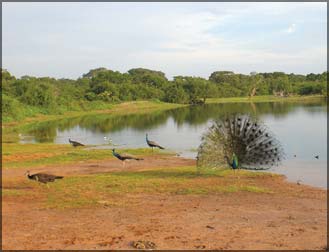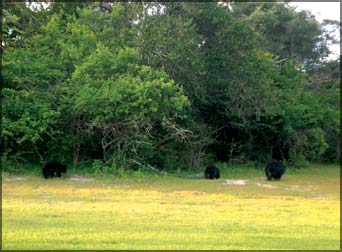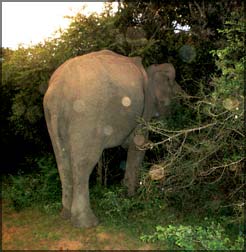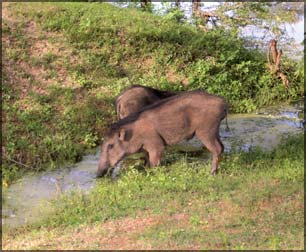|

Go wild in Tissa
Ganga PRADEEPA
 When
we hear about Tissamaharama we feel that it is a sunny and difficult
journey. But actually it is the golden city in the Southern province
which has many attractions for a visit on your valuable holiday. When
we hear about Tissamaharama we feel that it is a sunny and difficult
journey. But actually it is the golden city in the Southern province
which has many attractions for a visit on your valuable holiday.
The season’s festival “Go Wild in Tissa” organised by the Hambantota
District Chamber of Commerce and Ruhunu Tourism Bureau in Tissamaharama
commenced on December 27 and concluded on the 29.
When you reach Thissa you can visit Yala National park, Kirinda,
Tissa temple, Yatala temple, Ramba viharaya, Hummanaya blow hole,
Ussanagoda, Bandagiriya tank, hot water springs at Madunagala, Bata Atha
agricultural park and boat safari on Walawe river and also Tissa Lake.
Yala National Park
Yala National Park is 309 km south of Colombo on the South East of
the island. It is well known for its extensive the area of 1,259 sq km,
and for its careful wildlife preservation in the country. It is one of
the best parks in the world to observe and photograph leopards in the
wild and it is famous for its high density of leopards, perhaps the
highest in the world.
 |
|
peacock
were dancing in front of peahens |
The male leopards in Yala are very confident and are often seen
walking the tracks during the day.
You are also sure to see elephants – grumpy lone males during the dry
months and large herds in the wet season. Sloth bears are also a big
draw. You will also see mammals such as wild boar, several species of
deer and wild buffalo.
When we were entering Yala by jeep we saw two wild boars were
drinking water near the entrance and they looked at us as the
receptionists. Oh! It was a nice welcome for us after a long six hour
journey from Colombo.
After a few minutes we saw a plethora of reptilian species and
platoons of crocodiles. A big crocodile near the small lake, changed our
peace of mind for a few seconds. Wow! How enthralling it was!
As is common in Sri Lanka there is a huge diversity of stunning bird
life including migratory species such as the flamingo. It is also one of
the few places in the world where the severely endangered black necked
stork can till be seen.
Other than these animals we were lucky to see three bears together.
It was a rare scene because Yala National Park has about 20 bears. On
our two hour safari we saw five elephants with one of them approaching
our jeep.
 |
|
Three bears
together |
It was an exciting incident and a strange experience for us. My
companions Sajitha, Kanchana, Sagarika and I were shocked, but we kept
silent because we knew if we shout it would startle the elephants which
would be dangerous to say the least.
The uniqueness of the park is the sheer diversity of the habitat:
dense jungles suddenly give way to lagoons and open plain areas and the
park has a simply beautiful sea front.
If you go there you can also see Chital Deer, Wild Buffalo, Darter,
Black-naped Hare, Green Bee Eaters, Painted Stork, Spot-billed Pelican,
Yellow-wattled Lapwing, Sri Lanka Junglefowl, Malabar Pied Hornbill,
Parakeets, Sambar deers, Grey langurs, Indian Peafowl, Monitor Lizzards,
Grey Herons, Jackals and several species of birds.
The bird population is profuse, stunning and in November-January, the
fantail peacocks everywhere are unforgettable. This Yala safari is
enjoyable early in the morning or in the evening. Jeeps can be hired
from the Independent Safari Jeep Association.
The guides are employed by the conservation and wildlife societies
and must accompany all visitors to the park.
 |
|
An elephant
was approaching our jeep |
Actually I forgot to blink for a second. If I blinked I could miss
some animals and the sceneries. We saw nearly fifty peacock and the nice
part of this safari was these peacock were dancing in front of peahens
to take there attraction. But most of the peahens ignored there
beautiful dance and escaped from the peacock.
Go wild in Tissa was a pleasant surprise and I can say it was one of
the highlights of our tourism industry also. I would recommend it to
everyone who like to travel there and take unforgettable experiences
like us during this season.
Ramba Viharaya
The Ramba Viharaya was set up during the time of king Mahanaga. The
ruins of ancient buildings, shrine rooms, Buddha and other statues is
evidence that a large number of Bhikkus lived there. The are had been
overtaken by robbers later and the shrine had become the target of
treasure hunters.
Kirinda
The Queen Viharamahadevi was cast adrift in the sea as a sacrifice.
She found herself on the Kirinda coast to be saved by King Kavantissa.
The ancient temples, ruins and caves which housed female bikkhus are
within the sanctuary itself, and the pada yathra pilgrim’s route from
Batticaloa to holy Kataragama passes through it. From the rocks, a
statue of an early queen looks out over the sea; representing a part of
Sri Lanka’s heritage and a dynasty that reigned for centuries.
Yatala Temple
 |
|
Wild boars
were drinking water |
The oldest dagoba in Tissa is the Yatala temple, built 2,300 years
ago by Yatala Tissa, the brother of King Devanampiya Tissa. He
constructed it to mark his miraculous escape from a assassination
attempt by his sister-in-law.
That he was given refuge in Tissa for his wife to give birth made
Yatala Tissa swear that he would build this temple after establishing
his kingdom here. He built many more buildings in his capital, including
a palace and monasteries.
Tissa tank
A boat ride on the Tissa tank is a popular activity. This ancient
reservoir was constructed in the 3rd century BC by an early Sri Lankan
king.
A tour of the lake today includes a trip around bird watcher’s
delight with its many bitterns, herons and egrets.
Rekawa The turtle conservation project
Rekawa is located on the border of two climatic zones there is a high
local level of biodiversity. As well as the mangrove forests, the local
vegetation consists of scrub jungles, medicinal plants, fruit trees and
a wide variety of wildlife including 150 resident and migratory birds,
27 species of mammals, 23 species of reptiles, many arthropods and
aquatic life (Kapurusinghe T 1994 unpublished report)
Although coral mining is illegal in Sri Lanka, the coral reefs
immediately offshore of Rekawa beach have been mined by the community
for the production of lime. The mangrove forests have been extensively
cleared to provide firewood for the lime kilns.
Rekawa Kalapuwa is a large lagoon of 250 hectares, which is
surrounded by mangrove forests. The neighbouring villages of Netolpitiya,
Medilla, Marakolliya, Kapuhenwela and Wellawatugoda also border the
lagoon and the fishermen from these villages depend on the lagoon
fishery.
The fishery consists of several species of fish and the more
economically viable shrimp. Community members have been involved in the
removal of shells for lime production and sand for use in the
construction industry.
However, today, shells and lagoon sand are difficult to collect and
this has lead to local dependence on other resources (Ganewatte et al.
1995).
A causeway has been built across the narrow westerly section of the
lagoon. The causeway has increased accessibility to the village of
Kapuhenwela but has reduced the natural exchange of sea and lagoon
water.
This has lead to a change in the quality of lagoon water causing a
recent dramatic reduction in the lagoon fishery’s productivity. In order
to maintain catch size many local fishermen now use nylon nets, a
practice that has contributed to the over-exploitation of the lagoon
fishery.
The degradation of the fishery has meant that lagoon fishermen have
had to look to other resources for income generation.
The 2 km of Rekawa beach immediately westwards of the Rekawa headland
provides nesting habitat for populations of 5 species of marine turtle.
For at least 20 years, local villagers have collected almost 100 % of
the turtle eggs laid on Rekawa beach and some adult females have also
been harvested.
Simpson’s Forest
Tharindu ILLEPERUMA
Simpson’s Forest is a small sub- montane forest patch in the
Hunnasgiriya mountain extending towards the Wattegama Elkaduwa Road,
located at an elevation of about 1300 m above msl. This triangular-
shaped forest patch, which looks like a gallery forest, was protected as
a watershed by a former planter named Simpson.
This trail goes though a tea plantation interspersed with exotic
plants such as Grevillea robusta, Erythrina spp, Eucalyptus spp and a
small forest patch of Albizia spp, Toona spp and many fern species. The
forest gap area is dominated by Bu-kenda, Kenda at lower elevation and
Katu-Kitul a palm especially adapted to sub-montane areas.
To Simpson forest you can go by vehicle or if you like you can walk
along the Wattegama narrow road. But if you go by vehicle you have to be
careful because it was too difficult and narrow for to pass.
Reach to the forest road you have to drop your vehicle near to the
tea estate and you have to walk along the footpath trough the tea
estate. While walking you can see the beauty of Hunnasgiriya mountain
and the mist every where.
After few steps we reached some ruins which is called Coffee
Bungalow. The remnants of this bungalow, which is believed to be more
than 150 years old, commonly referred to as the Coffee Bungalow is the
other interesting feature found on the way to Simpson’s forest.
Simpson’s forest is a refuge for a variety of birds species including
several endemics such as the Sri Lankan Hill Myna, Sri Lanka White Eye,
Hanging Parrot, Yelleow- fronted Barbet as well as Sri Lanka Frogmouth
and the Crested Tresswift among others.
Two birds of prey viz the Black eagle and the Crested Serpent Eagle
are also a frequent sight at this location. This is also a habitat for
the Giant Squirrel and two large and beautiful butterflies, the Blue
Mormon and the endemic Tree Nymph.
The path to Simpson’s forests offers a panoramic view of the
beautiful landscape of the area, showing the undulating terrain of the
scattered mountains, valleys, gaps and stunning rocky outcrops. The two
major cities of the hill country namely Kandy and Matale can be seen
clearly.
You will experience the effect of changing micro climatic conditions
while walking through this forest patch.
When we go to this Coffee Bungalow we can see Hunnasgiriya mountain
very well. The elevation at the summit of Hunnasgiriya is 1490m msl. The
higher elevation levels especially above 900m msl are covered by sub
montane forest.. The trek to Hunnasgiriya peak traverses through the
estate road along which a few waterways cross the road.
Tea is planted up to an elevation of 1200m feet and scattered tress
such as Thorny Dadap, African Tulip, Eucalyptus Spathodea spp and
Grevillea spp. Can be seen among the tea bushes. During most of the day
the vegetation at higher elevation is covered by mist, hence a lush
growth of moss and fern can be found on tree trunks, as well as on the
ground.
At the summit a panoramic view of the surrounding area can be seen
including the Knuckles range, Victoria reservoir, Kandy, Hantana range,
Bible rock and Valleys atc. Black eagle and Black Bulbul are some of the
bird species found at the higher Dunuwiliella a cascading waterfall.
Priyankara Hotel Blend of natural and modern comforts
Ganga PRADEEPA
 Priyankara
Hotel at Tissamaharama, a five and half hour’s drive from Colombo was
opened in 1995 as a three star hotel. It is a fine place for visitors to
the South Lanka who come to see the glittering landscape at
Tissamaharama and Hambantota. Priyankara
Hotel at Tissamaharama, a five and half hour’s drive from Colombo was
opened in 1995 as a three star hotel. It is a fine place for visitors to
the South Lanka who come to see the glittering landscape at
Tissamaharama and Hambantota.
This hotel has 30 deluxe rooms with private balconies that overlook
the emerald green acres of paddy fields and the sparkling streams. The
rooms are a perfect blend of natural aesthetics and modern comforts.
You’re sure to catch the sight of a few of the exotic birds at the
nearby bird sanctuary making a friendly appearance every now and then
and each morning your wake up call will be their harmonious chirping.
The restaurant serves both Sri Lankan and international cuisine. The
swimming pool situated between the restaurant and the paddy field, adds
glamour to the hotel where you can relax and unwind in the blue waters
of the pool.
At the entrance to the hotel is a lobby. It is decorated with blue
and white colours of combination giving a beautiful view to the guests.
The three storeyed hotel complex has its atmosphere enriched with
greenery and large escape of paddy fields.
The staff always treats the guests with courtesy. “This is a family
owned property and we have very good demand from both Sri Lankan and
foreigners who visit Yala, Bundala and places of religious significance
at Tissamaharama” said the Hotel’s Managing Director Priyankara
Wickramasekara. |



